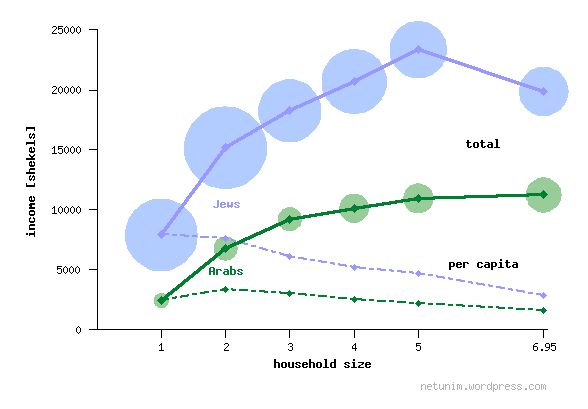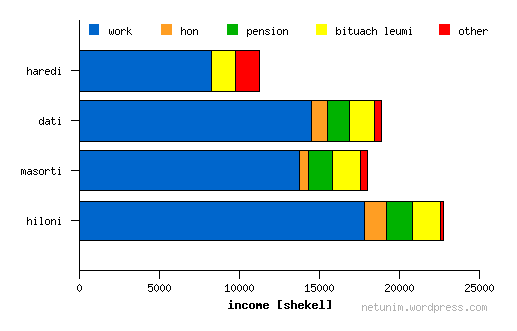Apartheid In Action: The data show that for every household size, the net income of Arabs is less than half that of Jews
Posted on July 13, 2018 by michaellee2009
Marginal income
לפני שנה הלמ”ס הוציאו את פרסום 1677, שעניינו הכנסות והוצאות של משקי בית לפי סקר משנת 2015. מתוכו בחרתי להסתכל על נתוני ההכנסה של מגזרים בשוליים של החברה הישראלית — הערבים והחרדים. צריך לעשות את זה מדי פעם כדי להיזכר שממוצעים לא בהכרח משקפים את כולם. יש הרבה שונוּת / אי-שוויון. A year ago, the Central Bureau of Statistics removed publication 1677, which deals with income and expenditure of households according to a survey from 2015. From this I chose to look at the income data of sectors in the margins of Israeli society – the Arabs and the ultra-Orthodox. Everyone has a lot of variance / inequality.
נתחיל עם הערבים. Let’s start with the Arabs. הגרף הבא מציג את רמת ההכנסה נטו של משקי בית ערבים לעומת יהודים. The following graph shows the net income level of Arab versus Jewish households. הציר האופקי הוא הגודל של משק הבית (מספר נפשות; הנקודה האחרונה משקפת את הגודל הממוצע של משקי בית עם 6 נפשות או יותר). The horizontal axis is the size of the household (number of persons, the last point reflects the average size of households with 6 persons or more). מהנתונים רואים שעבור כל גודל של משק בית, ההכנסה נטו של ערבים היא פחות מחצי מזו של יהודים. The data show that for every household size, the net income of Arabs is less than half that of Jews. החריג היחיד הוא משקי הבית הגדולים ביותר, שאצל יהודים הם בעיקר משקי בית חרדים, אבל אפילו במקרה הזה ההכנסה של יהודים גבוהה פי 1.76. The only exception is the largest households, where Jews are mainly Haredi households, but even in this case, the income of Jews is 1.76 times higher. הפער הזה הוא בחלקו בגלל רמת תעסוקה נמוכה יותר , ובחלקו בגלל שכר ממוצע נמוך יותר.This gap is partly due to a lower level of employment , partly due to lower average wages.

שטחי העיגולים משקפים את מספר משקי הבית מכל גודל. The area of the circles reflects the number of households of all sizes. זה מצביע על הבדל מעניין נוסף: אצל יהודים מספר משקי הבית קטֵן ככל שיש בהם יותר נפשות, ואצל ערבים ההיפך – משקי בית גדולים הם הנפוצים יותר. This indicates another interesting difference: among Jews, the number of households is smaller as they have more people, and among Arabs the opposite is true – large households are more common. ובמשקי בית גדולים ההכנסה לנפש נמוכה יותר. And in large households the per capita income is lower. משקי הבית הקטנים (1-2 נפשות) הם בעיקר של קשישים. The small households (1-2 persons) are mainly of the elderly.
ועכשיו לחרדים. And now to the ultra-Orthodox. הגרף הבא משווה את הרכב ההכנסות של חרדים עם זה של מגזרים יהודים אחרים בשנת 2015. משק בית חרדי מכניס בערך חצי ממה שמשק בית יהודי אחר מכניס מעבודה. The following graph compares the income of Haredim with that of other Jewish sectors in 2015. An ultra-Orthodox household puts in about half of what another Jewish household brings in from work. בנוסף, לחרדים אין הכנסות משמעותיות מהון, פנסיות, וקופות גמל. In addition, the ultra-Orthodox do not have significant income from capital, pensions, and provident funds. לעומת זאת יש להם הכנסות גבוהות משל מגזרים אחרים מהקצבות ותמיכות יחודיות (בניגוד לקצבאות הביטוח הלאומי, שדומות עבור כל המגזרים). On the other hand, they have higher income than other sectors from allowances and special support (unlike National Insurance benefits, which are similar for all sectors).

מקורות Sources
הכנסות והוצאות משק הבית: נתונים מסקר הוצאות משק הבית 2015 . Household Income and Expenditure: Data from the Household Expenditure Survey, 2015 . פרסום 1677 של הלמ”ס, 13.7.2017. הנתונים על משקי הבית בגדלים השונים של ערבים לעומת יהודים מלוח 6. הנתונים על הרכב ההכנסות של משקי בית יהודים ברמת דתיות שונה מלוח ב’ במבוא. Publication No. 1677 of the Central Bureau of Statistics, July 13, 2017. Data on households of different sizes of Arabs versus Jews Table 6. Data on the composition of income of Jewish households on a religious level differs from Table B in the Introduction.
No comments:
Post a Comment